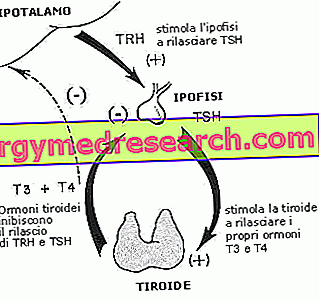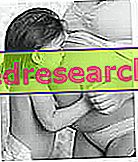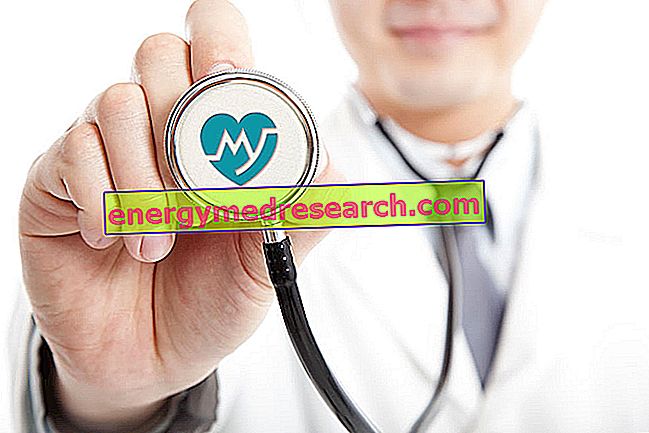Generality
Thyrotropin- releasing hormone is a small pepetide produced by the hypothalamus. Also known as TRH (an acronym from the English word " Thyrotropin Releasing Hormone "), once secreted by the hypothalamus, it reaches the anterior pituitary, where it stimulates the release of hormones: thyrotropin (TSH), prolactin (which ensures the milk supply at the end of pregnancy) and growth hormone (GH).

In the presence of hypothyroidism, it is the duty of the endocrinologist to ascertain whether the "responsibility" for failure to stimulate the thyroid is to be attributed:
- To the pituitary gland, which for various reasons does not secrete TSH (eg tumors or pituitary traumas);
- The hypothalamus, which does not produce TRH, does not stimulate the pituitary to release TSH.
What's this
Also known as Thireotropin Release Factor ( TRF ), TRH is a small molecule, consisting of the union of three amino acids: pyroglutamic acid, histidine and proline.
The target of the hormone is the anterior pituitary (adenohypophysis).
Biological role and functions in the body
TRH, which stands for Thyrotropin Releasing Hormone, is a hypothalamic tripeptide with an important endocrine action. The TRH acts on particular cells of the anterior pituitary, stimulating them to secrete TSH and prolactin. TSH, in turn, has the thyroid as the target organ, where it exalts hormone synthesis and secretion, increasing the release of T3 and T4.

In addition to stimulating the secretion of prolactin and TSH, TRH has extraendocrine activity that has not yet been fully clarified. Not by chance, in the form of a precursor (pro-TRH), it is secreted in many extra-hypothalamic tissues, such as the thyroid itself (parafollicular C cells), the pancreas, the myocardium and the reproductive organs.
Why do you measure
The TRH test, also known as TSH stimulation test, is a useful exam for the study of the thyroid and, to a lesser extent, to investigate possible causes of female infertility.
The test is essential in some cases of hypothyroidism, to check whether the thyroid's inability to produce thyroid hormones is due to:
- Alterations of the thyroid gland itself (primary hypothyroidism);
- Failure to release the anterior pituitary gland of the TSH (Thyroid Stimulating Hormon), the thyroid-stimulating hormone (secondary hypophyseal hypothyroidism);
- Inability of the hypothalamus to secrete TRH (hypothalamic hypothyroidism).
TRH stimulus test
After exogenous administration of TRH, TSH levels reach maximum plasma concentrations within 20-30 minutes. A missed response of TSH levels to the injection of 200 µg of TRH is observed in the presence of hyperthyroidism, secondary hypothyroidism related to pituitary insufficiency and therapy with dexamethasone or corticosteroids. An exaggerated response to this test is observed instead in patients with primary hypothyroidism, therefore due to thyroid problems.
To assess the patient's response to the injection of TRH, it is obviously necessary to compare post-administration TSH levels with baseline levels; the examination therefore requires a double collection of venous blood.
In addition to evaluating the pituitary reserve of TSH, the TRH stimulus test can evaluate the pituitary reserve of prolactin. After the hormone injection, prolactinemia reaches the highest levels within 10-30 minutes. A missed response to TRH is observed in panipopituitarism and in subjects suffering from prolactin-secreting hyperprolactinemia tumors.
Normal values
Normally, following the administration of TRH during the stimulation test, the following responses are observed:
- Prolactin increases from 2 to 15 times half an hour after injection and stabilizes within 90-120 minutes;
- The TSH doubles within 20-30 minutes of injection, with a maximum value exceeding 10 mU / ml.
TRH High and Low - Causes
The normal function of TRH may be impaired in the presence of damage to the hypothalamus cells that synthesize the hormone.
TSH
If the TSH is high and increases after stimulation, it is a sign of hypothyroidism; if the TSH does not increase, hyperthyroidism is likely.
In a hypothyroid subject, a mild positive response directs the diagnosis towards a pituitary lesion.
Prolactin
In a patient in whom excessive secretion of prolactin is found, the positive result of the test points towards a non-pituitary cause, while a negative outcome may indicate a lesion of the pituitary (adenoma).
How to measure it
The TRH test involves the administration of the synthetic hormone to the patient, identical to the natural product. Subsequently, the TSH is measured at fixed times.
It is therefore a dynamic test : the basal dosage (first dosage of TSH) is followed by intravenous inoculation of 200 micrograms of TRH; then, another 5 venous blood samples are taken at a distance of 15, 30, 45, 60 and 90 minutes from the basal dosage, in order to measure the hormonal response to this stimulation.
The TRH test for the study of prolactin secretion usually requires 6 samples taken within 2 hours of TRH injection, 15 minutes apart.
Preparation
Before the test it is necessary to observe a fast of at least 8 hours, during which a small quantity of water is allowed.
To avoid repeated puncture of the vein in the arm, a needle-cannula is applied, which is removed when the patient finishes the test. Like all tests in which a substance is administered, informed consent must be signed.
Interpretation of Results
The TRH test is used to ascertain if the poor functioning of the thyroid is caused by:
- Deficiency in the thyroid itself (primary hypothyroidism);
- Lack of stimulation of the gland by TSH (secondary hypothyroidism).
After administration with TRH, 5 different responses (TSH variations) can be observed depending on the type of dysfunction:
- Subject with normal thyroid function : after 30 minutes of stimulation, a physiological increase in TSH values is observed;
- Primitive hypothyroidism : exaggerated increase in TSH after 30 minutes (3-4 times the baseline value);
- Pituitary hypothyroidism : no increase in TSH after 30 minutes;
- Hypothalamic hypothyroidism : increase in TSH delayed over time (after at least 60 minutes);
- Hyperthyroidism : no increase in TSH compared to the baseline value.
In practice, the physiological increase in TSH values does not occur in cases where the disorder is pituitary. In this case, the pituitary does not react to the stimulus and the already low basal TSH values do not increase after stimulation with TRH. Conversely, if the pituitary is sensitive to TRH, but this hormone is not produced by the hypothalamus, 60 to 90 minutes after stimulation, the pituitary gland begins to produce TSH.



